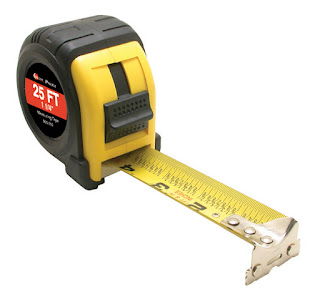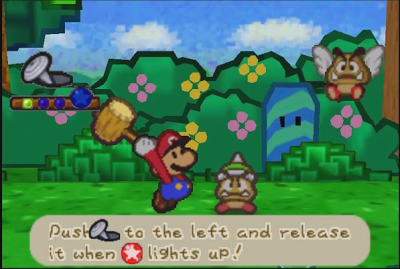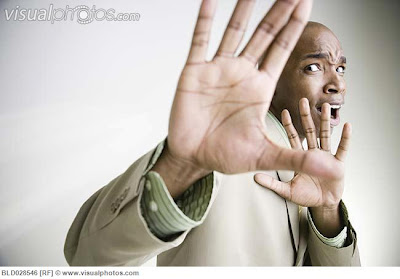[Note: As I was finishing writing this review I had noticed a prevalent
trend. Although I don’t regret it because this a blog of my opinions rather
than a completely impartial outlet, here’s a fun drinking game I’ve devised:
take a drink every time I compare Sticker Star to other Mario RPGs. Good luck.]
So I return, metaphorically jumping out of the casket at
a comical moment to inform everyone that I am not, in fact, dead. This past
month of academically induced radio silence holds the new record for longest
amount of time I’ve spent without updating the blog. So now that the honeymooning
period of updates every week or two is over I’ve moved boldly forward in the
realm of not updating, soaring to new heights with the new lows I’m willing to
set. Um, that is to say that, I’m like, reaching a new low in actuality, but I’m
using the phrase new heights to refer to the new record in lows I’m setting,
which on reflection is kind of confusing. I mean, it’s sort of like the lows
are the lowest because they’re the highest speaking in terms of lows, sort of
like if gravity were flipped upside-down and flying high in the sky would actually
be burrowing underground, but oh wait that would mess up the low part of the
analogy. Er…
Okay I can figure this
out, lemme just get out my tape measure…
I’m reviewing
Paper Mario: Sticker Star today! There? Was that so hard? Anyway, submerged
within my self-imposed exile last month, I spent a large amount of time playing
through Paper Mario: Sticker Star for the 3DS, just as the prophecy foretold. If
by ‘prophecy’, you mean ‘the last review I wrote’. Having just finished the
game the other day, I’m left with a number of things I wish to say about it.
However, before we get to the main review, there’s a bit of background I want
to set.
In 1996, Nintendo decided to leverage its then friendly
relations with Squaresoft (the people behind the Final Fantasy series who later
merged into Square Enix) to create a spin-off Mario RPG named Super Mario RPG: Legend of the Seven Stars.
I never played this isometric RPG myself, but I’ve heard good things about it
(enough that I probably will one day). Years later a different developer named
Intelligent Systems took up the helm of Mario RPGs and released the otherwise
unrelated game Paper Mario. It was a
Nintendo 64 game released in 2001, at the tail-end of the systems life span,
and it was completely fantastic.
I cannot emphasize enough how much I love this game. I
was enraptured with it as a kid, as it was a solid RPG with a well-written and
often humorous story, wrapped up in a cute storybook aesthetic. It used
something called action commands, wherein you had to input button prompts in
order for your attacks to deal more damage, to bring timing and skill into the
otherwise slow and strategic system of turn-based combat. The system worked
brilliantly, and the combat had plenty of other nuances that gave it depth. There
were different types of attack to deal with different types of enemies, a
system of badges acting like a simplified (but more meaningful) version of equipment,
and an array of upgradeable combat partners who could be switched out to use
their various different attacks (or different abilities out of combat). The
game was fun to play, was filled with charm and personality, and to this day
I’ve played it from start to finish something like 7 times.
Eagle eyed readers may be able to discern the slight
possibility that I like this game.
In 2004, the Nintendo Gamecube saw the release of Paper Mario: The Thousand Year Door by
the same company. The attitude of the game was a bit more cynical and silly,
which lost a bit of the storybook innocence that fills me with nostalgia for
the first. Beyond that, though, it was superior in every way. The combat saw
numerous improvements, like a much expanded roster of action commands and
tactical decisions to make. The game was funnier, it was longer and had more to
do, the visuals were better, and so on. It took a game I absolutely loved and
improved on it slightly in almost every way.
In 2007, another Paper Mario game was released on the
Nintendo Wii, Super Paper Mario. The
game was a major departure for the series, as it had no turn based combat and
instead consisted of a side-scrolling platformer with RPG elements, like upgradeable
health. Like many people, I viewed this as a major disappointment. On the plus
side, the writing was still decent and could make me laugh from time to time.
Although as a side note, the game was considerably weirder than its
predecessors, featuring lots of strange polygonal characters, and I have to say
that the focus on being odd and funny may have hurt other aspects of the games
writing. It was certainly amusing, but I didn’t care about the world or the
characters much as a result of its increasingly flippant attitude. The bottom
line is this is a game that I never finished, though it was good enough that it
lies on my titanic list of ‘would be nice to finish someday’ games.
Given how much I liked
the first two and how much I’ve got to say about the series as a whole, I’ll
almost certainly revisit these games another time. But for now, I’ve used up
enough space on an article about a completely different game.
At the gaming convention E3 in 2010, another unnamed
Paper Mario game was announced for the upcoming Nintendo 3DS. I have no doubt
other people, like me, were happy to see the beloved RPG series making a
reappearance, and as further information was released another point of
happiness surfaced: the game was going to be a turn-based RPG again! Genre-savvy
readers may spot the telltale signs and see what comes next. Yes, ladies and
gentlemen, there’s no doubt that some hype backlash affected my and
many other people’s opinions of this game. Despite that I’ll do my best to keep
the review on the more objective side. So before we get started on specifics,
I’ll get the verdict out of the way: Paper Mario: Sticker Star is a good game,
but not a fantastic one, and definitely not quite as good as some of its
predecessors (which, to be fair, rank among my favorite games of all time). Let’s
start with the most obvious difference the game has from its predecessors, and
why that particular change didn’t quite stick.
Oh god I’m sorry put down the baseball
bat!
In Paper Mario: Sticker Star, you have an album of
stickers for things like Jump and Hammer, which are your only method of
attacking enemies in the games turn-based combat. The stickers are one use, so
if you run out of jump stickers you need to find or purchase more to use the
attack again. Don’t worry about running out of stickers however, as you’ll
almost never do so due to the plethora just lying around and ridiculous
abundance of coins to buy more (by half way through the game or so I was
approaching the coin cap of 9999 and had to start buying things to prevent
this). Rather, the resource management comes in saving your good stickers for
the proper time.
When a turn starts in Sticker Star, you can pay some coins to make a roulette wheel spin. If you get two or three of the same symbol,
you get that many attacks (and a bonus depending on what the symbol is if you get three
in a row). For each attack you choose one sticker. You can’t choose what enemy
you target with a sticker, but rather the game goes down the line for each
additional command (first attack hits the first enemy, second attack hits the
second, etc). This lack of choice is somewhat mitigated by the fact that a
large amount of stickers hit all/multiple targets. However, I’d still call it a
point against the game that reduces the amount of tactical depth in the combat.
When you win a battle, you get coins, and sometimes the enemy drops a sticker.
If you win a battle in the first turn, it’s a perfect victory and you get more
coins.
An image of combat for
illustrative purposes, which is too boring to make a joke about.
See a problem with this? The game has no experience
points, no equipment, and almost no means of progression other than single-use
stickers and coins to purchase them. The only concession to permanent upgrades
the game gives is a series of HP-Up hearts that can be found to increase your
maximum health. Now combine these facts with the earlier one about me constantly
approaching the max amount of coins. The sad truth to the matter is that there
isn’t actually much incentive to fight enemies at all a good portion of the
game. You waste your limited stock of stickers to get more of gold you don’t
need, in larger amounts than required to keep yourself stocked. Before the
games final level, I filled my sticker book with as many stickers as I could
and still had over 8000 coins left over. It’s like they confused the production
of this game with New Super Mario Bros 2.
Y’see, it’s funny
because New Super Mario Bros 2 was a game about collecting a lot of coins. And
this game has you collecting a lot of coins. Do you see? Do you see why my joke
is funny? Oh god what is with you
and that baseball bat?!
Sadly I’m not done listing ways in which the combat
doesn’t match its predecessors. In the previous games there were a variety of
action commands that made use of all sorts of different button inputs with
different approaches and timings. Sticker Star has some variety in that regard,
but action commands only consist of
hitting the A button at the correct times. The previous games had Flower Power
and Star Power, resources for special attacks. This game doesn’t really need
them due to all attacks being handled by stickers, but the lack of them gives
the player less to manage and simplifies combat further. The old games had an
array of partners to Mario who had their own in-combat attacks, out-of-combat
abilities for puzzle solving, and unique dialogue. Those are absent in this
game as well. And well we’re on the subject of missing dialogue, let’s talk
about this games writing…
Paper Mario Sticker Star is not a poorly written game.
It’s never quite as well written as its predecessors, but it’s still amusing in
its own right and features some respectable writing. The problem is that it
doesn’t have enough of it. Sticker
Star has a very sparse plot, which in spite of the occasional amusing moment
has very little to offer compared to other Paper Mario games or RPGs in
general. The games main villain, Bowser, doesn’t have a single line of dialogue
despite having plenty (and being a generally amusing character) in the other Mario
RPGs. There aren’t very many memorable characters, and the majority of the speaking
roles in the game are from generic Toads. When one of the most memorable
characters in a game whose series was previously known for memorable characters
is “that Toad who is bad at driving a boat”, it’s a problem.
On a related note to most of the speaking roles being
Toads, Sticker Star seems to be a bit generic and safe as far as casting of
characters. Every enemy and character in the game is a version of normal
Mario characters. Though I suppose I’m sounding like a broken (and bitter)
record at this point, the previous games kept exploring new lands and
introducing new types of characters and mythologies. I can’t help but worry
that the same Nintendo that released four similar New Super Mario Bros games
has made a concentrated effort to keep things safe for their flagship character that has bled over into this
game as well. Whatever the case may be on that front, however, the roster of
characters in this game is disappointing. In the previous games the majority of
the bosses had backstories, personality and plenty of speaking lines, and were
often completely unique. In Sticker Star the bosses are all versions of known
Mario characters who say almost nothing at all.
The second boss is
literally just a regular enemy sprite made larger and shiny. I’d expect this
kind of thing from an MMO with hundreds of bosses, not a game with only six major ones.
I’ve been pretty negative about the game so far, so I
should probably dial it back for a second to give some perspective. Despite my
complaints about it being less enjoyable than previous efforts, the combat in
Paper Mario Sticker Star can be still be pretty fun at times. In case you
couldn’t tell from the previous screenshots, the game looks pretty good for a
handheld, with bright, colorful and clean visuals. And if there’s one thing in
the game I definitely like, it’s the music. I’d still say the soundtrack of
Sticker Star isn’t quite as good as
its predecessors, but those are some fantastic
soundtracks to compare something to and it’s at least in the same class as
them.
The Mini-Boss battle
theme is an excellent example of Sticker Stars jazzy, electronic style of
music.
Reoccurring minion
Kamek’s theme is so catchy it almost makes me forget about how annoying his
fight mechanics are. Freakin’ sandals.
Gooper Blooper, the third
boss, may have my favorite song in the game. Each turn he progresses to a new
variation on the song and a new attack. If you deflect his final attack with a
Sponge sticker, he gets poisoned instead of you, and the jazzy mix of the Super
Mario Bros Theme starts playing. Quite satisfying.
Sadly, this transitions into another problem I had with
the game. You see, there are things in Sticker Star that are literally called ‘Things’,
three dimensional objects that can be turned into stickers. These are key to
solving the games “puzzles”. I put puzzles in quotes because it’s the old adventure
game style puzzles, where you insert object A into slot B to succeed. For
example, once I had to melt some snow. I tried using a Match sticker on the
wooden-looking structure where you could put a sticker, but that didn’t work. I
was far enough into the game at that point that I had given up trying to
understand its bullshit and simply looked up the solution online. It turned out
I needed to use the Radiator sticker, because clearly that’s the only obvious
way to melt an entire mountainside of snow, and no other type of fire will do.
Not all sticker puzzles are that bad, some being better at indicating what you
need and some allowing multiple stickers of the same type (as that one should
have). But even the best of these puzzles still end up with you having to go
back to town to get the sticker again (you can only have one copy of each Thing
sticker at a time) if you don’t have it.
The most egregious example of this type of gameplay is in
the game’s boss battles. Though some are better than others, most of the boss
battles in this game follow a basic pattern. They’re insanely difficult (or in
some cases I think literally impossible) to complete, unless you use a certain
Thing sticker. Their weakness exploited, they then become ridiculously easy.
The first problem with this is it throws away what normally makes boss battles
so engaging. Boss battles in RPGs are usually a test of all the skills learned so far,
at their best open-ended strategy challenges where the player has to think of a
valid tactical solution to defeating their opponent, and winning a boss battle
because you had the right item destroys that. The second problem is that it’s ridiculously likely that when you first
encounter the boss you won’t have the right item to beat them. You’re
presumably not clairvoyant or else you would know the rest of this review
already and wouldn’t keep reading, so chances are the first time you encounter
the boss you won’t have the correct sticker. Even if you do, you might use it
at the wrong time. It takes a lot of trial, error, and returning to town and
for all that doesn’t feel like solving a puzzle so much as a war of attrition,
which makes just looking up weaknesses online beforehand more appealing. This seems
to me like bad game design, pure and simple, and it bothers me a fair bit.
This was the first
boss, and I had to fight long and hard to beat him as I didn’t have the item
exploit his weakness. After beating him, the game mentioned that I used a lot
of stickers and there might have been an easier way. Well, yeah, but there isn’t any more because the fight is already
over. Later bosses are even less forgiving, often stun-locking you, making
you always miss or being invincible if you don’t have the right sticker.
So that basically sums up my opinions on Paper Mario
Sticker Star. I hate to sound so negative all this time, because it’s actually
a decent game that I had fun with. The problem is that’s all it is. It’s design flaws keep it firmly as a ‘good’ game rather
than a ‘great’ or ‘fantastic’ one, and it’s most certainly not (say it with me
one more time) as good as the previous Mario RPGs. It’s still good enough that
you can enjoy it, and I’ll leave you readers to decide based on my opinion and
others whether it’s a game you want to own. I just hope that Intelligent
Systems and Nintendo one day put out another Paper Mario game as good as the
old ones. Because if this game is any indication of the direction they’re
taking, the odds of that are thin. Paper thin.
Wait, what sticker are
you…oh dear.












No comments:
Post a Comment